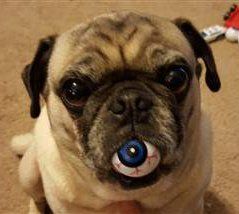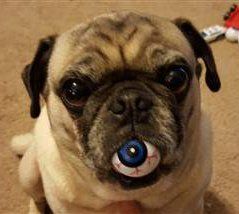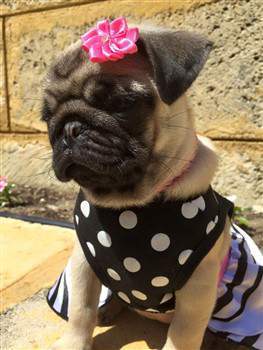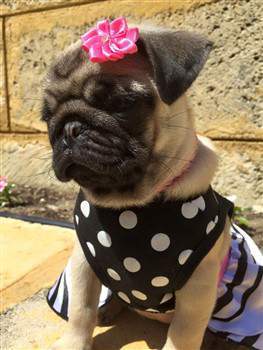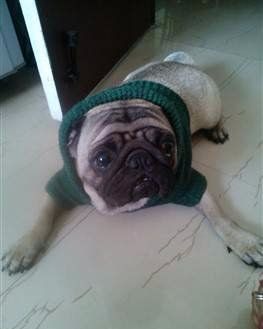Pug Dog is Peeing in the House
Overview
It’s not uncommon for us to hear from owners who have a Pug that has suddenly started peeing in the house for no reason. Or so it may seem. Fortunately, if a Pug puppy or dog begins peeing inside there is always an answer as to why. And this means that the problem can be resolved. There are also issues of puppies that have never quite seemed to fully understand the housebreaking rules.
This section will cover many of the common situations that can occur, along with steps to fix it. Among the scenarios we’ll discuss will be:
- Peeing right after being outside (as soon as the dog comes back into the house)
- When home alone
- Only at night
- Early in the morning
- Blatantly in front of you
We’ll also go over some important facts that can help prevent spraying/marking issues, senior Pug incontinence and more.
Pug is Peeing Inside Right After Coming Back In
This is one of the most common issues seen, it most often applies to puppies though a Pug of any age may start to do this (though often for other reasons).
Puppies
– Before a puppy is thoroughly house trained, he may pee anywhere, there is no place off limits as long as the pup can reach it. Everything is fair game. The Pug puppy may pee behind the sofa, in closets or right smack square in the middle of your living room. And, while it would be nice to know exactly when a puppy needs to pee, it can be quite random as the pup is slowly learning how to control his/her bladder muscles and things such as excitement and distraction can affect when he pees as well.
Adults
– With adult Pugs that are fully house trained most only will pee inside if they have no choice. And this comes about if the dog is inside without any ability to reach his designated bathroom area. Many adult Pug dogs can hold their needs for 8 hours. For some it will be a bit less and for a few it may be a tad more. However, in general, you can’t expect for more than 8 hours and will need to plan accordingly.
Brody and Lacey Mae
Photo courtesy of The McCain Family
in Hicksville OH
How to Fix This:
1) Make a schedule. When you are home, make a schedule for taking your Pug out and stick to it. You'll want to do this:
- As soon as the Pug wakes up (in the morning and any time after arising from a nap).
- Every couple of hours. Every 2 hours for puppies and every 4 hours for adults is suggested
- Right before bedtime (within 20 minutes of sleep time)
2) Choose a bathroom area.
When you bring your Pug out, bring him to one area (a designated spot, used only for bathroom needs). This helps reinforce the idea that peeing and pooing should be done outside of the house. With your Pug on leash, you choose the area; your puppy or dog can choose the exact spot.
3) Stay outside long enough.
While the actual act of peeing takes less than 1 minute, you’ll want to give your Pug at least 15 minutes. Why? Some need time to focus (they’ll first listen to outdoor sounds and take in all the sights and smells) and then need time to relax (unless a Pug has been holding his needs for a long time, in which case the bladder may immediately release, he/she may need some time for the bladder muscles to relax and release).
In addition, dogs like to choose exactly where they will go. And finally, this will also give him time to poo as well. Many dogs will pee first, there will be a pause of 5 or 10 minutes and then they will have a bowel movement.
4) As soon as you get back inside
– If your Pug has a habit of peeing as soon as they get back inside, a neat trick to help stop this from happening is to immediately hold the puppy in your lap. Don’t worry, the idea behind this is that 99.9% of pups won’t urinate when being hold in that way. So, keep him on you for a good 10 minutes and then carry him right outside again. In most cases, the dog will then urinate. Be sure to give praise and reward. Repetition is how dogs learn, so this will need to be done every time, for 1 to 2 weeks.
Pug Pees Inside Only at Night or Early in the Morning
Since a dog peeing late at night when everyone is sleeping or super early in the morning when you might still be in bed or just waking up, we’ll tackle both of these issues together.
Very young puppies
(under 8 months old) may simply not be able to hold their needs throughout the night and as they mature, things will get easier. With dogs over 8 months old, a couple of adjustments can often solve this issue.
How to Fix This:
1) Adjust dinner time.
This is one of the most effective methods if a Pug goes to the bathroom early in the morning before you are ready to wake up. It works very well if a Pug has a bowel movement early in the morning but also works for peeing. While most dogs receive the bulk of their water via lapping up their water
dish, hydration also comes from their food (more so for wet food, but to some extent for kibble). And dry food can cause a Pug to drink more after a meal than he would otherwise.
You probably have a set schedule of when you give your Pug dinner; most often when you come home from work or when you eat dinner yourself. However, a dog’s body takes a certain amount of time to process food and water. If a dog is going to the bathroom early in the morning, this means that from the time that he ate to the time that he woke up (10 hours, for example), the food was processed and waste is ready to be expelled.
If you move his last meal up by 1 to 2 hours, the time in the morning will be extended as well. For example, if a Pug keeps waking up at 5 am to pee and poo if you move dinner up by 2 hours, he often won’t need to go to the bathroom until 7 am. If your Pug is very hungry, offer a light snack so that he can wait to be fed at the later time.
Tip:
Your dog may still may need to pee as soon as he wakes up, however. This is common, since the body is working all night long and as soon as a dog rouses from sleep the bladder is full and the need to pee is strong. Most Pugs will stay sleeping if they don’t have to poo, which means that they will be waking up at a later time that better matches your own schedule.
2) Contain your Pug.
If your Pug sleeps
on your bed, it may be time to rethink this arrangement until he no longer pees inside. It is best to keep him behind a gates area or in a playpen (more ahead).
Pug Pees Inside When Home Alone
It’s important to have realistic expectations as to what a Pug is able to do and then take steps to help the dog as much as possible.
How to Fix This:
1) Be sure to allow ample time
before you leave for your Pug to go to the bathroom in his outdoor designated area.
2) Limit Access.
While you can’t stop a dog from peeing if he must go, you can control where this happens. This breed tends to be claustrophobic and does terrible if put into a crate. For this reason, a gated off area in a room without carpeting or making use of a good sized canine playpen is best. You’ll want your Pug to have room to play, eat, rest and go to the bathroom.
Dupree Baity, 7 years old
Photo courtesy of Jamie Baity & Brandon Olson
So, he’ll have his bed, toys, food & water bowls. Any other floor space should be covered with pee pads. Most dogs will not pee on their belongings and certainly not on their food, so the chances are high that most urine will end up on the pads.
One problem that some owners encounter is that the puppy rips up the pads. This can be resolved by duct taping the ends down on all 4 sides. If you are worried about ruining your floor, you can obtain an appropriately sized piece of linoleum from a home supply store to place down over your own flooring.
Pug Pees Inside When Owners Are Home
While you want your Pug to have freedom and feel comfortable at home, if your puppy or dog leaves the room only to leave a puddle of urine in the next one, some changes will need to be made.
How to Fix This:
Limit Access
– Unlike when your Pug is home alone, a dog does not need to be sequestered to one spot, but you will need to keep an eye on him. Any time that you can do so, tether him to you. This is done by placing a harness on the puppy and attaching a leash to that (we do not recommend just a collar, as the neck can be jerked, causing injury). The other end of the leash connects to you (the belt loop works well) and this way, you can keep your Pug within your line of sight. Any time that he/she makes a motion to pee, immediately scoop the dog up and bring him to the bathroom area (even if you must carry him to do so).
Tip:
If you catch your Pug in the act, pick him up and quickly bring him to his bathroom area, even if this leaves a trail of pee and even if he barely finishes going once there. This helps him realize that peeing should be done in that one spot and praise & reward should be given for 'finishing correctly'.
Be sure to keep taking him out on schedule, and not just when he appears to need to pee.
For those times that you can’t keep an eye on him, use the method of the gated off area or playpen. Read more
about why playpens are beneficial for Pugs in many ways
or
see our top recommendations here:
Peeing Vs Marking
These are 2 different things and will need to be dealt with differently. If a dog is peeing inside, he is emptying his bladder, and this makes it a house training issue which can be stopped by following the guidelines already discussed. If a dog is marking inside, he is spraying just
some urine and this makes it a behavioral issue.
Both male and female
dogs mark, though males do tend to do this more often. And dogs of any age can do this, even ones that are 100% trained. It is important to note that intact dogs do mark more than those that are fixed, however if your dog pees inside after
being neutered or spayed and you identify it as marking behavior, following steps #2 and #3 (ahead) should help.
If your Pug has started marking in the house, some big changes will need to be made to fully resolve the issue.
How to Stop a Pug from Marking:
1) Spay/Neuter
– While this is not guaranteed to stop marking completely, it puts the odds way in your favor. Aside from reducing the likelihood of territorial marking, there are many health benefits as well such as reduced chance of developing some cancers. So, you’ll want to speak to your vet about this.
2) Establish Yourself as Leader
– At any time during pet ownership, your dog may start to question your authority. Or the hierarchy of the house may never have been taught to him. If a dog starts to forget, this can happen for any number or reasons… An owner may start to slack off in regard to caring if the dog listens to commands or may have inadvertently taught the dog that he gets what he wants, when he wants. And a dog can begin to either think that he himself is the leader of the house OR he may start to wonder if he can, perhaps, become the leader.
And once this happens, a dog will strut around as if he is in command, marking all over the place to claim ownership.
One of the ways to combat this, is to make it 100% clear that you – the owner – is the Alpha of the house.
Here are some tips:
1.
Nothing is given for free. Any toy that your Pug wants, any food (both meals or snacks), essentially anything at all that the dog wants must be ‘earned’ by obeying the ‘Sit’ command.
2.
The human enters and exits the house first.
3.
In severe cases, the dog should not be allowed up onto the same physical level as the human (up on the sofa, the bed, etc.)
4.
Teach the dog all basic commands of: Sit, Stay, Down and Come.
Ruby, 14 weeks old
Photo courtesy of Jane King
There may
be a phase when the dog takes on the challenge... Once his human steps up to take charge, a dog may not back down... a Pug can be more stubborn than ever and pee inside even more often. Do not back down. You'll need to outlast your dog. Hold your ground and stick to the new rules.
3) Clean the Area Properly
– If anything triggers a dog to pee in one certain area, it’s the fact that he/she has already pee’d there once before. You would think that scrubbing the area with water and soap would be good enough, but it’s not. Urine contains certain enzymes and if it is not cleaned with a quality enzyme neutralizing solution, there will be trace amounts left. You will not be able to see them or smell them, but your dog will be able to pick these up. And this is akin to a loud announcement saying “Pee here again!”.
If a Senior Pug Pees Indoors
It is not uncommon for an older,
senior Pug dog to start to display signs of weakening bladder muscles. If this is a matter of age related issues, there are some treatment options including medications to help strengthen urine control.
However, no matter how old a Pug is, suddenly having problems holding in urine should not be written off as old age. In many cases, it is a matter of a health issue. And these issues can affect a dog of any age.
Doodle, 1 year old
Photo courtesy of Rakesh
Health Issues that Can Cause Incontinence - Pugs of Any Age
Any Pug, from the 8-week old puppy to the 12-year-old senior can suddenly begin to pee indoors and have little or no control over their urination due to a health issue. For this reason, it is really important to have these issues ruled out before you start to look at it as a house training, age or behavior issue.
A few of the most common reasons include:
- Urinary tract infection
- Urinary stones
- Kidney infection
- Kidney stones
- Bladder infection
- Bladder stones
- Back/spine issues
- Prostate disorders
- Diabetes
These issues cannot be treated at home. Professional veterinary treatment is necessary to diagnose and treat (most often with prescribed mediation).
Reminder Tips
Here are the top 8 tips to stop a Pug from peeing inside:
1.
Have all health issues rules out before taking any other steps.
2.
Have one designated bathroom area. Always bring your Pug to this spot. Go there before you take him for a walk or play with outside with him for exercise. Have a pathway cleared so you can bring him even if it’s snowed. Repetition of using this one spot will help him learn.
3.
Bring your Pug outside often. Don’t just wait until he makes the motion of peeing.
4.
Give your Pug a good 15 minutes to go to the bathroom.
5.
Keep your Pug confined to one small area via playpen or gates for when he’s home alone or when he can’t stay right by your side.
6.
If there are issues that happen very early in the morning, move your Pug’s last feeding
up by 2 hours.
7.
If your Pug is marking, take immediate steps to establish yourself as the Alpha of the home and considering having your dog fixed.
8.
Clean any urine with a high quality canine urine enzyme cleaner to prevent repeats.
Summary
Pugs are one of the most lovable breeds in the world and not only do they carry an expression that says “It’s not my fault!” it is also true that peeing in the house is not their fault. Expecting them to hold their needs for too long of a time, leaving them free to pee wherever they want without understanding where the bathroom area is or expecting them to hold their pee and poo after waking up…. These are all things that fall to us, the owners.
It’s important that we patiently teach our Pugs what is expected, praise and reward for deeds well done and forgive mistakes and accidents along the way.


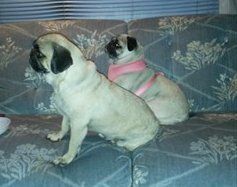
-237x257.dm.edit_UAcqg3-400w.jpg)
